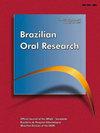Impact of the COVID-19 pandemic on sleep quality and sleep bruxism in children eight to ten years of age.
IF 2.5
4区 医学
Q2 Dentistry
引用次数: 5
Abstract
This study aimed to determine the impact of the COVID-19 pandemic on sleep quality and possible sleep bruxism (SB) in children eight to ten years of age. The study hypothesis was that sleep disturbances influenced a higher occurrence of bruxism during the COVID-19 pandemic. A longitudinal study was conducted at two time points: in person prior to the COVID-19 pandemic (T1), and online during the pandemic (T2). The sample comprised 105 children. Parents/caregivers answered a questionnaire addressing sociodemographic characteristics, the use of electronic devices, reported (vs. clinical) SB, and the Sleep Disturbance Scale for Children (SDSC) at both T1 and T2. McNemar's and Wilcoxon's tests were used to compare SB and sleep disorders at both time points. Poisson regression analysis determined the relative risk (RR) among the variables, and the incidence of possible SB (p≤0.05). The comparison of the two time points (T1 and T2) revealed a significant increase in possible SB (p<0.01) and sleep disorders (p < 0.04). Children whose parents had a lower schooling level (RR: 2.67; 95%CI: 1.19-6.01), those with their own electronic devices (RR: 1.97; 95%CI: 1.09-2.50), and those with sleep disorders during the pandemic (RR: 1.74; 95%CI: 1.35-2.24) were at greater risk of developing SB during the pandemic. Moreover, the incidence of bruxism and sleep disorders was greater during the pandemic. The factors influencing SB incidence during the pandemic were a lower level of mothers' schooling, greater access to electronic devices, and the occurrence of sleep disorders.COVID-19大流行对8至10岁儿童睡眠质量和睡眠磨牙的影响
本研究旨在确定COVID-19大流行对8至10岁儿童睡眠质量和可能的睡眠磨牙症(SB)的影响。该研究的假设是,在COVID-19大流行期间,睡眠障碍影响了磨牙症的更高发生率。在两个时间点进行了纵向研究:在COVID-19大流行之前(T1)亲自进行了调查,在大流行期间(T2)进行了在线调查。样本包括105名儿童。家长/看护人回答了一份调查问卷,内容涉及社会人口统计学特征、电子设备的使用、报告的(与临床的)SB,以及T1和T2的儿童睡眠障碍量表(SDSC)。采用McNemar's和Wilcoxon's测试比较两个时间点的SB和睡眠障碍。泊松回归分析确定各变量之间的相对危险度(RR),以及可能发生SB的发生率(p≤0.05)。T1和T2两个时间点比较,可能的SB (p<0.01)和睡眠障碍(p< 0.04)明显增加。父母受教育程度较低的儿童(RR: 2.67;95%CI: 1.19-6.01),有自己的电子设备的患者(RR: 1.97;95%CI: 1.09-2.50),以及大流行期间有睡眠障碍的患者(RR: 1.74;95%CI: 1.35-2.24)在大流行期间发生SB的风险更高。此外,在大流行期间,磨牙症和睡眠障碍的发病率更高。影响大流行期间SB发病率的因素是母亲受教育程度较低、电子设备使用较多以及睡眠障碍的发生。
本文章由计算机程序翻译,如有差异,请以英文原文为准。
求助全文
约1分钟内获得全文
求助全文
来源期刊

Brazilian Oral Research
DENTISTRY, ORAL SURGERY & MEDICINE-
CiteScore
3.70
自引率
4.00%
发文量
107
审稿时长
12 weeks
 求助内容:
求助内容: 应助结果提醒方式:
应助结果提醒方式:


